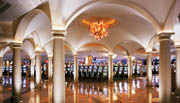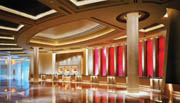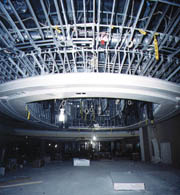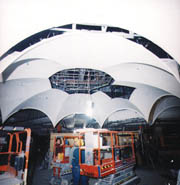

"This is the most elaborate casino I've worked on," Suckle says, "and had the highest level of finish of anything I've been exposed to before by a long, long way."
Despite the challenge of the project, KHS&S won the job through a competitive bid process and got to work.

High stakes
The official bid was on the low-rise portion of the project, which included the casino and some back-of-house areas, with the contract being awarded in early 2002. This was the first new casino to be constructed in Atlantic City in almost a decade. Work on the project began at the end of February 2002."Our first reaction after viewing the demands of the project was how to proceed in a timely manner," Suckle explains. "We organized ourselves because the biggest part of the job was the planning. The biggest responsibility for me was understanding the drawings-very elaborate drawings-and how we were going to frame for these ceilings."
Luckily, the deadline was adaptable although the casino was scheduled to be open on the Fourth of July, 2003. The project was a two-part collaboration between an architectural firm that did the base building design, BLT and Cope Linder, of Philadelphia, and the interior design by consultant Dougall Design, of Los Angeles. Dougall designed the aesthetics.
One of the highlights of the project was the ceiling of the gaming area and the reception area.
"The ceiling is constructed of drywall and glass reinforced gypsum," Suckle adds. "It starts with a sub-ceiling grid. We installed with a heavy-duty grade grid, manufactured by Armstrong, that was built specifically for constructabilty. This was because we suspended soffits from the drywall grid with direct-hung connections to the superstructure itself."
The ceiling was very ornate with custom GRG ceiling tiles, custom coffers, custom light reflectors, groin vaults and custom crown moldings. The ceiling required 35,860 pieces of GRG product and 27,000 lineal feet of framing.

Roll the dice
"To construct the ceiling of the gaming area, we broke apart each individual soffit into component parts and we manufactured the component parts with 35 different jigs that we built in the first months of construction," Suckle says. "We just laid out and fabricated these component parts. This fabrication was done onsite."Initially, KHS&S started with a sub-ceiling and built four large rolling scaffolds 20 feet by 40 feet wide. Apparently, Suckle was happy with the progress: "We went through there like Sherman through Georgia."
In terms of scheduling, first the mechanicals went in then the soffit framing. The ceiling incorporated the HVAC plenum work into the soffits themselves and progress went well with the mechanical contractor.
"The majority of soffits were radiused not straight," he says. "This added to the difficulty but we knew we could do it. When framing concurrent with the GRG supplier (Formglas Interiors, of Ontario, Canada), they were very helpful. We engineered a system where we would eliminate drywall and incorporate it into the GRG, a lot of the parts and pieces. Where drawings showed a flat drywall ceiling, we had pieces manufactured with the GRG as a component member. This added cost to the GRG but eliminated labor with the drywall, and finishing."
Formglas provided the shop drawings, reviewed by the architect, and did an outstanding job.
"We first start receiving the GRG around August 2002 and we pretty much were complete by end of June 2003," he adds.
After the ceiling was completed there was a lot of faux painting to be accomplished, even wall covering in some cases. On some of the ceilings and intricate groin vaults, the GRG was out of sight in terms of price, and for these, KHS&S had to do it with metal lath and wire, and conventional plaster.
Along with the ceilings and the vaults, there were 70 Tuscan columns, fabricated out of textured GRG, along with thousands of square feet of textured GRG on the wall surfaces. The texture simulated limestone and there were three different colors to be integral to the GRG.

Waterworks and other tasks
In addition to the intricate ceiling, KHS&S did three water features: In the reception area, there is a 28-foot-high water wall, featuring a continuous flow of water over acrylic panels that lets light show through the panels.At a "highland games" area, the company built a fountain water feature with a cherry wood bridge and GFRC surrounds around the fountain and lighting within the fountain (that features a continuous waterfall).
In the retail piazza area, the company built a fountain with a continuous waterfall on a radius. This was also surrounded with GFRC and custom tile work for the radius tops and planters within them. KHS&S installed 3,650 slot machine bases and slot machines, along with 148 table games.
The fountains and slot machines the company constructed were not part of the original contract but the owners were so "pleased by the ceilings and walls," the contractor earned the opportunity to bid other work.
"Nothing was handed to us," Suckle adds.
For his crew, planning ahead was the biggest thing, to anticipate the progress of the mechanical, electrical and plumbing contractors.
"When you plan your manning of a project, you plan well in advance of the product deliveries and the products to be installed," he continues. "Planning is the key. Once you've established that, the individual fabrication of component members is the next task. Everyone has a task and we create a production line. We have to keep in mind the schedule and always be aware of the budget."
